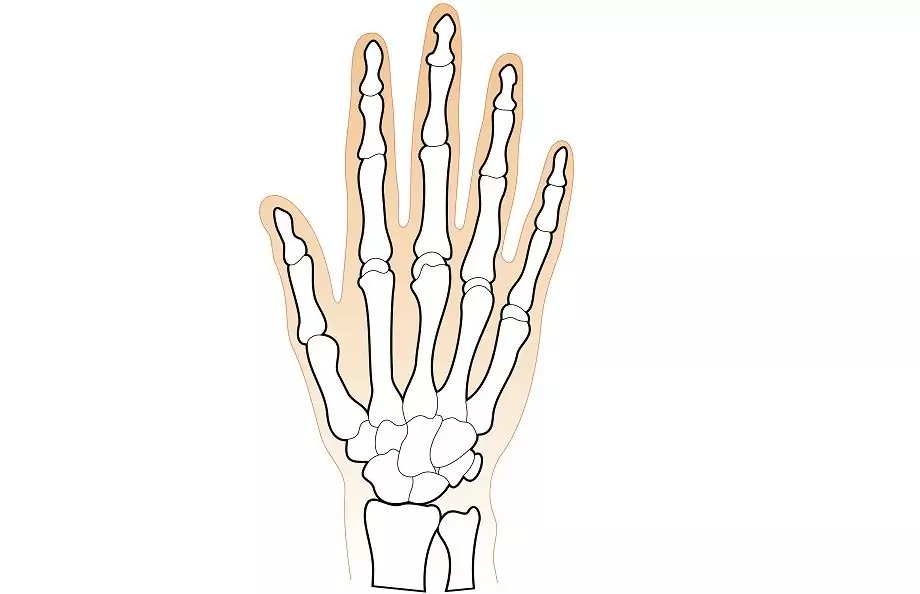- Author Rachel Wainwright [email protected].
- Public 2023-12-15 07:39.
- Last modified 2025-11-02 20:14.
Hygroma of the wrist
The content of the article:
- Causes and risk factors
- Forms
- Symptoms
- Features of the course of the disease in children
- Diagnostics
- Treatment of the hygroma of the wrist
- Possible complications and consequences
- Forecast
- Prevention
Hygroma of the wrist is a benign tumor-like formation in the form of a connective tissue capsule filled with articular fluid. Generally, the terms “hygroma” and “synovial cyst” are considered interchangeable.

Source: file.youlai.cn
Up to 70% of the wrist hygromas are localized on the back of the wrist, less often there are hygromas of the palmar surface and the wrist joint, which are usually found in the projection of the radial artery. This pathology is widespread among the working-age population aged 25 to 50 years.
Causes and risk factors
The formation of a wrist hygroma is similar to the process of hernia formation. Normally, during hand movements, the joint fluid moves inside the capsule of the wrist joint, lubricating the rubbing surfaces of the wrist bones. Sometimes the walls of the articular bag become thinner and form protrusions in the weakest areas, which are gradually filled with synovial fluid coming from the articular cavity and tendon bags, forming a hernial sac, which gradually increases in volume.
The formation of hygromas is facilitated by excessive loads on the wrist joint and frequent injuries of the wrist during professional sports, music or small monotonous manual labor, especially with constant repetition of the rotational movements of the hand. Wrist hygroma is common among musicians, seamstresses, embroiderers, hairdressers, typists, massage therapists, and other professions associated with prolonged wrist stress. For this reason, the incidence among women who are more likely to engage in handicrafts is one and a half to two times higher than among men.
In some cases, the hygroma of the wrist is the result of an unsuccessful operation or a complication of bursitis or tendovaginitis. The risk of developing a hygroma increases with a long chronic course of the inflammatory process and degenerative changes in the tissues of the articular bag caused by metabolic disorders or aging of the body.
Forms
Based on the characteristics of the pathogenesis, there are three main types of wrist hygroma:
- mucous - develop against the background of deforming arthrosis of the wrist joint: constant trauma to the articular structures due to the growth of osteophytes leads to the proliferation of connective tissue and the formation of a cyst;
- post - traumatic - resulting from mechanical damage to the articular bag;
- tendon ganglia (ganglions) - are formed as a result of a violation of the differentiation of the cells of the tendon membranes; are distinguished by severe pain and limitation of joint mobility.
Depending on the structure of the neoplasm capsule, two types of wrist hygroma are distinguished:
- single-chamber - characterized by the absence of connective tissue septa inside the capsule;
- multi - chamber - inside the capsule there are one or two partitions or more.
As a rule, multi-chamber hygromas are rare and in especially advanced cases.
Symptoms
Hygroma of the wrist for a long time does not manifest itself in any way, with the exception of a slight swelling in the area of the wrist joint. The growing neoplasm spreads the ligaments, tendons and surrounding tissues and compresses the nerve fibers, causing discomfort in the hand area. At first, a swelling appears on the wrist, which later turns into a soft, fluctuating, rounded tubercle up to 5 cm in diameter. The neoplasm is inactive, but the displacement of the skin is not disturbed. If the synovial cyst is located under the tendon, the growth of the neoplasm can go unnoticed for a long time. With a large cyst, discomfort and limitation of hand mobility may occur.

Source: zdorovie-sustavov.ru
With intensive production of synovial fluid, the growth rate of the wrist hygroma reaches 1-2 cm in a few days. Compression of the nerve trunks entails the appearance of paresthesias: the patient may complain of burning, numbness, tingling and a feeling of "goose bumps" around the hygroma or downstream of the nerve. In the case of squeezing of blood vessels, a cold snap and pale skin around the neoplasm is possible, and in men, in addition, thinning of the hair can be noticeable due to insufficient nutrition of the follicles.
The hygroma is distinguished from bruises and hematomas by their characteristic local symptoms:
- thickening and coarsening of the skin;
- discoloration of the skin;
- pain that increases with stress on the wrist.
Features of the course of the disease in children
Hygroma of the wrist is rare in children. As a rule, its appearance is associated with a hereditary predisposition. If the synovial cyst is formed in the pre-pubertal period, it should be removed before puberty, as changes in hormonal levels can provoke rapid growth of the neoplasm.
Diagnostics
Hygroma of the wrist is easily diagnosed by a surgeon, traumatologist or orthopedist based on external signs. In order to exclude oncopathology, osteomyelitis and damage to the periosteum, X-ray and ultrasound of the hand are prescribed, as well as a biopsy of the tumor with histological examination. In the biopsy specimen of the fibrous capsule, two types of differentiated atypical cells can be present - spindle-shaped and spherical. Before removing the hygroma surgically, you will also need to do an ECG and pass a standard set of tests:
- general blood and urine tests;
- blood sugar test;
- tests for infectious diseases (syphilis, HIV, hepatitis B and C);
- coagulogram.
In some cases, additional analyzes and instrumental studies may be required, as well as consultations of narrow specialists - a cardiologist, neurologist, endocrinologist, vascular surgeon, etc. If the patient is 60 years of age or more, the consultation of a therapist is mandatory.
Treatment of the hygroma of the wrist
In about half of the cases, small hygromas (up to 1 cm) dissolve on their own when the load on the wrist joint is limited. The self-resolution of the hygroma can be accelerated by immobilizing the wrist. Physiotherapy methods are an effective addition:
- iodine electrophoresis;
- ultraphonophoresis of hydrocortisone;
- ultraviolet irradiation;
- mud wraps;
- UHF and shock wave therapy;
- paraffin therapy.
In acute inflammatory processes and complications of hygroma, physiotherapy is contraindicated.
In non-started cases, puncture of the hygroma can be performed with suction of the contents and the introduction of sclerosing drugs, however, the capsule of the hygroma remains in the same place and may begin to secrete synovial fluid again, which leads to a relapse. The likelihood of relapse with this type of treatment is estimated at 8-20%.

Source: sustav.info
To eliminate painful sensations, local remedies are used - anti-inflammatory ointments with an analgesic effect and warming compresses. With severe pain, novocaine blockade is performed with the introduction of glucocorticoids.
It should be borne in mind that symptomatic measures without etiotropic treatment give only a temporary effect. With a large neoplasm, radical removal of the wrist hygroma is required by open surgical excision of the capsule or endoscopically. After removing the synovial fluid, the wound is thoroughly cleaned and treated with an antiseptic solution, then the outlet is tied up and the mouth of the hygroma is strengthened with a tissue flap, after which healthy tissues are sewn to the subcutaneous fat and sutured. During the operation, the joint is immobilized, and in the rehabilitation period, which lasts about five weeks, it is fixed with a tight bandage or splint. The stitches are removed 7-10 days after the operation; in order to prevent purulent complications, a course of antibiotics is prescribed.
An alternative to surgical treatment is laser vaporization of the neoplasm. High-energy radiation destroys the hygroma, practically without affecting healthy tissue. In this case, the rehabilitation period is minimal, and relapses are unlikely. Due to the absence of scars, laser hygroma removal is aesthetically pleasing.
If minimally invasive surgical care is unavailable, you can resort to squeezing out the hygroma with a flat object under local anesthesia. For children under 10 years of age, the procedure is performed under general anesthesia. During the destruction of the capsule of the neoplasm, the joint fluid comes out into the surrounding tissues and gradually dissolves. Despite the simplicity of the procedure, it should only be carried out by a qualified specialist. Since the edges of the crushed hygroma can grow together over time, the possibility of a relapse is not excluded.
Possible complications and consequences
Hygroma of the wrist as a whole does not pose a threat to the patient's life and ability to work, however, the addition of a bacterial infection with subsequent inflammation can lead to serious consequences. Inflammation of the hygroma is often accompanied by adhesive processes and fusion of the articular membranes, fascia and tendon sheaths. As a result, there is an increase in pain in the wrist area and a progressive decrease in hand functionality.
There are cases of spontaneous opening of a hygroma with an outpouring of joint fluid into the surrounding tissues. This usually occurs when dropped or hit. As a result, extensive wounds are formed, and after a while multiple cysts may form at the site of the ruptured hygroma. Ruptures of infected cysts are especially dangerous: the accumulation of purulent contents between adjacent tissues leads to the formation of phlegmon and distant foci of suppuration with the prospect of the rapid development of generalized sepsis. To eliminate purulent complications, a course of antibiotic therapy will be required.
Among the postoperative complications, the most common is excessive scarring of the joint capsule and hemorrhage into the articular cavity in case of accidental damage to large arteries.
Forecast
Hygroma of the wrist is not prone to malignancy, but it can be troublesome due to its unaesthetic quality. Correctly performed surgical intervention and adherence to the doctor's recommendations during the rehabilitation period guarantee the cure and prevention of relapses. Conservative measures are effective only in the early stages of the pathological process.
Prevention
To prevent the formation of a hygroma on the wrist, it is important to prevent injuries and inflammatory diseases of the wrist joint, and if they do happen, seek medical help promptly without resorting to self-medication. Before performing sports exercises and when practicing handicrafts, accompanied by monotonous hand movements, it is necessary to fix the wrist joint with an elastic bandage, orthosis or a special bandage. A good effect is given by industrial gymnastics, which is desirable to be carried out every one and a half to two hours of continuous work. Schoolchildren, office workers and IT industry professionals should control the position of the limbs: while writing and typing from the keyboard, the forearm should lie on the table, and not hang in the air. When training with weights, it is important to ensure that the load is evenly distributed across the hand and wrist.
YouTube video related to the article:

Anna Kozlova Medical journalist About the author
Education: Rostov State Medical University, specialty "General Medicine".
The information is generalized and provided for informational purposes only. At the first sign of illness, see your doctor. Self-medication is hazardous to health!






